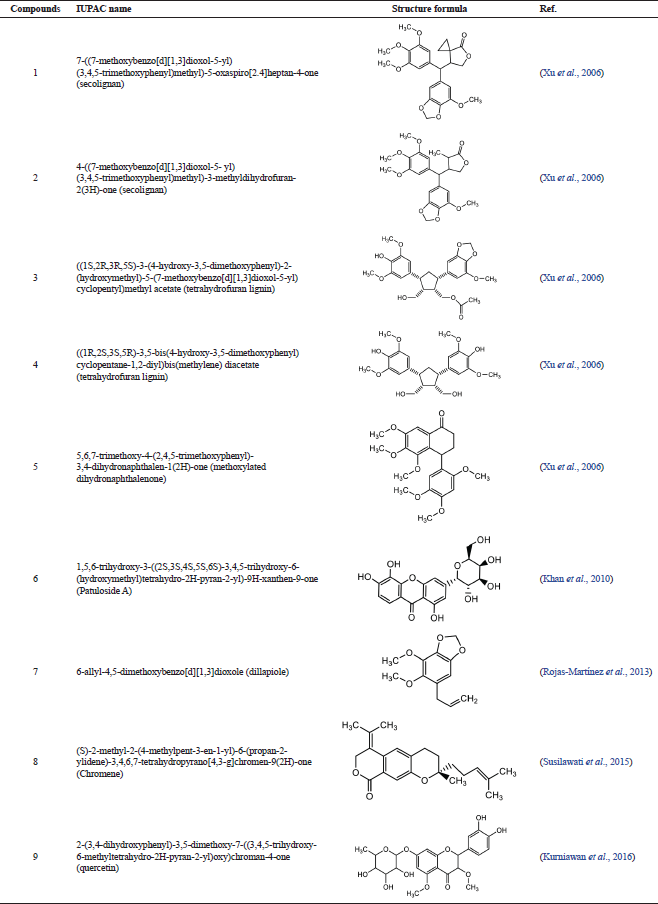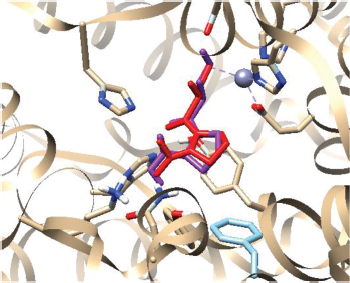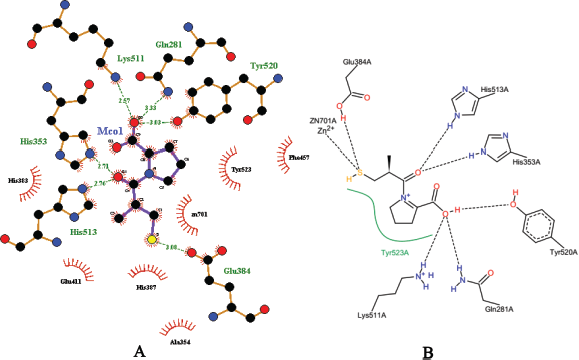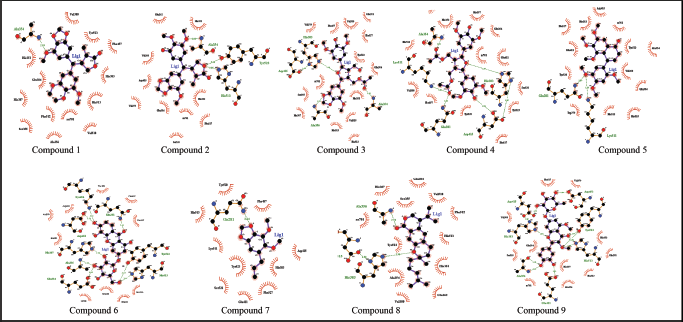INTRODUCTION
Hypertension or high blood pressure is one of the most top prevalent diseases in the world (Sorlie et al., 2014). In 2010, it was estimated 31.1% of adults worldwide had hypertension (Mills et al., 2016) and is predicted to increase by about 60% by 2025 (Kearny et al., 2005). Also, hypertension may increase risk factors for cardiovascular disease and has been associated with complications, such as stroke, heart attack, and kidney failure (Hartmann and Meisel, 2007).
One of the primary therapeutic agents for the treatment of hypertension is angiotensin-converting enzyme (ACE) inhibitors. ACE is one component of the renin-angiotensin-aldosterone system and plays a crucial role in the regulation of blood pressure (Skeggs et al., 1953; 1957). Metalloprotein residue of Zn2+ in ACE cleaves the His-Leu dipeptide from the inactivated C angiotensin I terminal (Ang I) and converting it into a potent vasoconstrictor in the form of angiotensin II (Unger, 2002). ACE has two isoforms, including: (1) glycoprotein form in somatic tissue with single large polypeptide chain of 1,277 amino acid and (2) in germinal cells that are synthesized in the form of lower molecular mass and play a role in sperm maturation and sperm binding of oviduct epithelium (Natesh et al., 2003; 2004). Currently, the crystal structure data from ACE is available in the form of PDB files that can be used for in silico molecular docking study.
In recent years, modeling methods based on computer simulations have become a useful tool in solving many scientific and engineering problems (Forli et al., 2016). In some conditions, computer-based modeling methods have become a bridge between applied or experimental science and theories of natural sciences, such as physics, chemistry, and biology quickly and precisely. When the simulation is compared with the experiment, it sometimes gives slightly different results (Ramachandran et al., 2008). Molecular docking is a process that searches for possible bonds of two molecules interacting under topographical conditions or energy considerations, the goal being to match the two molecules to the conformation in which has the best interaction (Santos-Martins et al., 2014; Seeliger and de Groot, 2010). One molecule (ligand) is docked to another molecular region (receptor) and from both molecules are calculated its interaction energy. In docking, its interaction energy is calculated by Van der Waals energy and Coulombic energy involved between all the atoms of both molecules (Ghosh and Gemma, 2014).
Natural products (mainly from plants) are the primary source for new drugs discovery. One of the herbs empirically used as a hypertension drug by the community in some countries is Peperomia pellucida (L) Kunth herb. According to the study reported by Saputri et al. (2015), the methanol extract of P. pellucida has ACE inhibitory activity with IC50 of 7.17 μg/ml and (Kurniawan et al., 2016) has reported that fraction and isolated quercetin of P. pellucida herb has IC50 of 3.44 and 7.22 μg/ml, respectively. Some polyphenols isolated from this herb includes secolignan (peperomins) and lignin (Xu et al., 2006), pellucidin A (Bayma et al., 2000), patuloside A (Khan et al., 2010), dillapiole (Rojas-Martínez et al., 2013), chromenes (Susilawati et al., 2015), and quercetin (Kurniawan et al., 2016). However, a study on ACE inhibitory activity (except quercetin) and the prediction of interaction conformation with ACE has not been reported.
In the present study, prediction of activity potency and interaction conformation of isolates from P. pellucida herbs with ACE have been conducted, which thus may expedite the development of further studies for new drugs discovery as ACE inhibitors.
MATERIALS AND METHODS
Materials
For in silico molecular docking study, a computer ASUS® (Taipei, Taiwan) with following specifications was used: processor Intel® Core™ i5-5200U CPU @2.20 GHz 2.19 GHz, 4.00 GB memory (RAM) DDR3, 64-bit Operating System, ×64-based processor, Windows Education 10.1, and NVIDIA GEFORCE 820 M VGA. Software installed includes ChemOffice Pro v15.00 PerkinElmer, Chimera 1.10.2., Ligplot+ v.1.4.5, AutoDockZn (http://autodock.scripps.edu/resources/autodockzn-forcefield), AutoDock v4.2.6 and AutoDockTools (http://autodock.scripps.edu/), Amber14 (operated via putty to connect with the server), Pymol, OpenBabel GUI, and PMV 1.9.2 (Phyton Molecular Viewer).
Receptor and native ligand structure preparation
The crystal structure of ACE (angiotensin-converting enzyme) in complex with captopril was downloaded from Protein Data Bank (rcsb.org/pdb/) with PDB id: 1UZF with 2.0 Å resolution. Ligand-protein docking was performed using AutodockZn program. AutoDockTools and OpenBabel programs were used to prepare and convert the type of the macromolecule complex and ligand file (O’Boyle et al., 2011). Furthermore, water molecules were removed from the macromolecule protein 1UZF; then the complete structure was converted, and hydrogen atom addition was done using Leap module of AMBER 14. The ligand file was subjected to the calculation of AM1-BCC partial atomic charges using antechamber module of AMBER 14 and minimization was done using Amber force field ff99SB. Then, the output (.crd) was converted to PDB by an ambpdb module of AMBER 14.
Ligand sample preparation
Structure of Ligand samples was acquired from some literature (as can be seen in Table 1) (Bayma et al., 2000; Khan et al., 2010; Kurniawan et al., 2016; Rojas-Martínez et al., 2013; Susilawati et al., 2015; Xu et al., 2006). 2D structure of ligand samples was built using ChemDraw® Pro 15 and was converted to the 3D structure using Chem3D® Pro 15. The MMFF94 atom types and charges of ligand samples were calculated, then minimization was performed using the MMFF94 force field minimization of Chem3D® Pro 15 (Wang et al., 2015). The minimized structure was converted to PDB format.
In silico molecular docking analysis
Docking of all the ligand samples was conducted using AutoDockZn (O’Boyle et al., 2011). The program was begun with ligands in different conformations and found the best docking on binding-site proteins using a Lamarckian Genetic Algorithm (LGA) to make one possible formation. The docking simulation was performed for the isolated compound using a protein receptor (PDB id: 1UZF). The autogridZn program was used to calculate the position of the grid. Based on the active site of Zn2+, the central grid was placed on Zn2+ with a box size of 40Á × 40Á × 40Á and a center of 40.835, 34.382, and 44.607 for selective inhibitors (MCO702) with a spacing of 0.375. The docking procedure was done using autodockZn program with 100 docking runs. Docking results were visualized using LigPlot+ and Poseview (Laskowski and Swindells, 2011; Stierand and Rarey, 2010).
RESULTS AND DISCUSSION
In silico molecular docking study aims to determine the potential of active compounds from natural products or synthetic. It is an approach for predicting potentially active compound based on the interaction and bonds types between the ligand and the active site of the receptor. This method is beneficial to predict the biological activity and interaction of ligand compounds quickly, accurately, and inexpensively.
In present study, in silico molecular docking study was performed to predict the potency of activity and interaction between ligand molecules in the form of native ligand (captopril) and the isolated polyphenol compounds of P. pellucida (consisting of nine compounds as listed in Table 1) on the ACE macromolecule (PDB id: 1UZF).
The docking of native ligand (captopril) gave Root Mean Square Deviation (RMSD) value of 0.96Á (<2), which means the docking results were valid with a ΔG value of −6.36 and clusters of 92% for the total of 100 times running. As can be seen in Figure 1, it shows the position between the native ligand and the docking results does not show significantly different locations (with the RSMD value <2). Figure 2 demonstrates the interaction between groups of the native ligand with protein (amino acid) and Zn2+ metalloprotein groups of an ACE macromolecule using LigPlus (A), PoseView (B). The binding mode of captopril in ACE macromolecule complex was investigated from its crystal structure (ID 1UZF). It is shown that the COOH and C=O groups of captopril formed hydrogen bonds with Tyr520, Lys511, Gln281 (with COOH) and His353, His513 (with C=O), respectively. The S-H group formed interaction with metalloproteins Zn2+ (with an atomic distance of 2.3 Å) and formed hydrogens bonding with Glu384. The bond forms of ligands from the docking results involved the hydrogen and hydrophobic bonds on clusters of amino acids and its interactions in the Zn2+ metalloprotein according to studies has been reported by Chang and Alli (2012) and Sharifi et al. (2013). This interaction (with distances of < 3 Å) indicated that the active site of each ligand has interaction with ACE macromolecule. In Figure 3, the binding mode of each compound in macromolecule demonstrated that the groups of each compound (except Compound 8) formed interaction with Zn2+ and Glu384. Meanwhile, His353, His513, and Tyr523 had interactions (hydrogen and hydrophobic bond) with groups of each compound, and another hand, another amino acid group had different interactions.
 | Table 1. The IUPAC name and chemical structure of polyphenols compound from P. pellucida. [Click here to view] |
 | Figure 1. Visualization of comparison between original and docking results position of the native ligand. Where a red is original crystallography and purple is docking results. [Click here to view] |
 | Figure 2. Visualization of docking results interaction between the native ligand and residue of ACE macromolecule (PDB: 1UZF) using (A) Ligplotplus and (B) dan Poseview. [Click here to view] |
Meanwhile, Table 2 demonstrates that the prediction of polyphenols compound from P. pellucida has potential to be developed as ACE inhibitors, it was indicated that docking results of each compound have lower affinity than captopril (with a binding affinity of −6.36 kcal/mol and the inhibition constant 21.81 μM) except Compound 7. Based on the results of calculation and docking analysis, similarity was exhibited between polyphenol compounds (except compound 7) with the native ligand. In the previous study, Guerrero et al. (2012) have predicted the interaction and bonds of luteolin (polyphenols group) using QSAR and molecular docking study of quercetin as a potential ACE inhibitor has been reported by Muhammad and Fatima (2015). Each amino acid residue can form seven different bonds or interactions with the ligand includes: (1) interaction of van der Waals bond, (2) interaction of aromatic face to face, (3) interaction of aromatic edge to face, (4) interaction of H-bond or protein as donor, (5) interaction of H-bond or protein as acceptor, (6) interaction of protein positively charged, and (7) interaction of protein negatively charged (Radifar et al., 2013). In addition, Table 2 also shows that some compounds have a potential active site with interaction distance between O atoms (ligand groups) and Zn2+ metalloprotein (protein receptor residue) at values less than 3Å, includes Compound 3, Compound 4, Compound 5, Compound 6, Compound 8, and Compound 9 with constant inhibition 752.52, 448.43, 10,740, 2,470, 517.42, and 831.04 nM, respectively. On other hands, Zn2+, Glu384, His513, His353, Gln281, Tyr520, Tyr523, and Lys511 are the binding site of ACE. The native ligand of captopril performs hydrogen bonding (Zn2+, Glu384, His513, His353, Gln281, Tyr520, and Lys511) and hydrophobic interaction (Tyr523). Based on the results of docking analysis, compound 5 has the most similar interaction with the captopril ligand where the compound binds to the active side of ACE as can be seen in Table 2, and these prediction results are in accordance with the molecular docking results of polyphenol compounds from Phyllanthus niruri herbs (Ahmad et al., 2018). In addition, some study has reported that extracts and fractions (with rich in polyphenol content) of this herbs have activity as an ACE inhibitor using in vitro assay method (Adhitia et al., 2017; Mun'im et al., 2017; Rinayanti et al., 2013; Saputri et al., 2015). Meanwhile, according to the previous study, Kurniawan et al. (2016) have done the assay of ACE inhibitory activity of Compound 9 (quercetin) with IC50 of 16.21 nM which has excellent correlation with the obtained docking result. Therefore, it is essential to proceed to further study, mainly isolation and identification of active compounds as ACE inhibitors of this plant.
 | Figure 3. Visualization of docking results interaction of isolated polyphenols from P. Pellucida and ACE macromolecule receptor (PDB: 1UZF) by Ligplotplus software. [Click here to view] |
 | Table 2. The docking results of captopril and polyphenol compounds from P. pellucida. [Click here to view] |
CONCLUSION
In conclusion, we have conducted in silico molecular docking to study the potential of polyphenol compounds from P. pellucida as an ACE inhibitor. The crystal structure of ACE (PDB id: 1UZF) bound to captopril was used as a protein target. Based on the docking result showed that the native ligand (captopril) was obtained RMSD value of 0.96Á (<2), which means the docking results were valid with a ΔG value of −6.36 and clusters of 92% for the total of 100 times running. Based on the interaction of ACE binding site, Compound 5 shows the most similar interaction with the captopril ligand where the compound binds to the active side of ACE compared to other compounds. Therefore, these results are preliminary data for further research with predictions of biological activity and interaction quickly, accurately, and inexpensively from the target compound.
ACKNOWLEDGMENT
This study was funded by Directorate of Research and Humanity Engagement (DRPM), Universitas Indonesia via “Hibah Tugas Akhir Mahasiswa Doktor Tahun 2018.”
CONFLICT OF INTEREST
All author declared that there is no conflict of interest
ABBREVIATIONS
ACE: Angiotensin-Converting Enzyme; DRPM: Direktorat Riset dan Pengabdian kepada Masyarakat; Gln: Glutamine; Glu: Glutamate; His: Histidine; IC50: half maximal inhibitory concentration; LGA: Lamarckian Genetic Algorithm; Lys: Lysine; MMFF94: Merck Molecular Force Field 94; P. pellucida: Peperomia pellucida (L) Kunth; PDB: Protein Data Bank; RMSD: Root Mean Square Deviation; Tyr: Tyrosine.
REFERENCES
Adhitia AM, Octaviani AN, Rissyelly, Basah K, Mun'im A. Effect of gamma irradiation on angiotensin-converting enzyme inhibition, antioxidant activity, total phenolic compound and total flavonoid of Peperomia pellucida herbs extract. Pharmacogn J, 2017; 9:244–8. CrossRef
Ahmad I, Mun'im A, Luliana S, Elya B, Azminah A, Yanuar A, Artha Y, Negishi O. Isolation, elucidation, and molecular docking studies of active compounds from Phyllanthus niruri with angiotensin-converting enzyme inhibition. Pharmacogn Mag, 2018; 14:601–10. CrossRef
Bayma JDC, Arruda MSP, Muller AH, Arruda AC, Canto WC. A dimeric ArC2 compound from Peperomia pellucida. Phytochemistry, 2000; 55:779–82. CrossRef
Chang YW, Alli I. In silico assessment: suggested homology of chickpea (Cicer arietinum L.) legumin and prediction of ACE-inhibitory peptides from chickpea proteins using BLAST and BIOPEP analyses. Food Res Int, 2012; 49:477–86. CrossRef
Forli S, Huey R, Pique ME, Sanner MF, Goodsell DS, Olson AJ. Computational protein-ligand docking and virtual drug screening with the Autodock suite. Nat Protoc, 2016; 11:905–19. CrossRef
Ghosh AK, Gemma S. Structure-based design of drugs and other bioactive molecules: tools and strategies.WILEY-VCH Verlag GmbH & Co. KGaA, Weinheim, Weinheim, Germany, 2014. CrossRef
Guerrero L, Castillo J, Quinones M, Garcia-Vallve S, Arola L, Pujadas G, Muguerza B. Inhibition of angiotensin-converting enzyme activity by flavonoids: structure-activity relationship studies. PLoS One, 2012; 7:1–11. CrossRef
Hartmann R, Meisel H. Food-derived peptides with biological activity: from research to food applications. Curr Opin Biotechnol, 2007; 18:163–9. CrossRef
Kearny PM, Whelton M, Reynolds K, Munther P, Whelton PK, He J. Global burden of hypertension: analysis of worldwide data. Lancet, 2005; 365:217–23. CrossRef
Khan A, Rahman M, Islam S. Isolation and bioactivity of a xanthone glycoside from Peperomia pellucida. Life Sci Med Res, 2010; 2010:1–10.
Kurniawan A, Saputri FC, Rissyelly, Ahmad I, Mun'im A. Isolation of angiotensin-converting enzyme (ACE) inhibitory activity quercetin from Peperomia pellucida. Int J PharmTech Res, 2016; 9:115–21.
Laskowski RA, Swindells MB. LigPlot+: multiple ligand À protein interaction diagrams for drug discovery. J Chem Inf Model, 2011; 51:2778–86. CrossRef
Mills KT, Bundy JD, Kelly TN, Reed JE, Kearny PM, Reynolds K, Chen J, He J. Global disparities of hypertension prevalence and control. Circulation, 2016; 134:441–50. CrossRef
Muhammad SA, Fatima N. In silico analysis and molecular docking studies of potential angiotensin-converting enzyme inhibitor using quercetin glycosides. Pharmacogn Mag, 2015; 11:123–6. CrossRef
Mun’im A, Nurpriantia S, Setyaningsih R, Syahdi RR. Optimization of microwave-assisted extraction of active compounds, antioxidant activity and angiotensin-converting enzyme (ACE) inhibitory activity from Peperomia pellucida (L.) Kunth. J Young Pharm, 2017; 9:168–71. CrossRef
Natesh R, Schwager SLU, Sturrock ED, Acharya KR. Crystal structure of the human enzyme—lisinopril complex. Nature, 2003; 421:1427–9. CrossRef
Natesh R, Schwager SLU, Evans HR, Sturrock ED, Acharya KR. Structural details on the binding of antihypertensive drugs captopril and enalaprilat to human testicular angiotensin I-converting enzyme. Biochemistry, 2004; 43:8718–724. CrossRef
O’Boyle NM, Banck M, James CA, Morley C, Vandermeersch T, Hutchison GR. Open Babel: an open chemical toolbox. J Cheminform, 2011; 3:1–14. CrossRef
Radifar M, Yuniarti N, Istyastono EP. PyPLIF: python-based protein-ligand interaction fingerprinting. Bioinformation, 2013; 9:325–8. CrossRef
Ramachandran KI, Deepa G, Namboori K. Computational chemistry and molecular modeling.Springer Berlin Heidelberg, Berlin, Heidelberg, 2008.
Rinayanti A, Radji M, Mun'im A, Suyatna FD. Screening angiotensin-converting enzyme (ACE) inhibitor activity of antihypertensive medicinal plants from Indonesia. Int J Pharm Teach Pract, 2013; 4:527–32.
Rojas-Martínez R, Arrieta J, Cruz-Antonio L, Arrieta-Baez D, Velazquez-Mendez AM, Sanchez-Mendoza ME. Dillapiole, isolated from Peperomia pellucida, shows gastroprotector activity against ethanol-induced gastric lesions in wistar rats. Molecules, 2013; 18:11327–37.
Santos-Martins D, Forli S, Ramos MJ, Olson AJ. AutoDock4Zn: an improved AutoDock force field for small-molecule docking to zinc metalloproteins. J Chem Inf Model, 2014; 54:2371–9. CrossRef
Saputri FC, Mun'im A, Lukmanto D, Aisyah SN, Rinandy JS. Inhibition of angiotensin-converting enzyme (ACE) activity by some Indonesia edible plants. Int J Pharm Sci Res, 2015; 6:1054–9.
Seeliger D, de Groot BL. Ligand docking and binding site analysis with PyMOL and Autodock/Vina. J Comput Aided Mol Des, 2010; 24:417–22. CrossRef
Sharifi N, Souri E, Ziai SA, Amin G, Amini M. Isolation, identification and molecular docking studies of a new isolated compound, from Onopordon acanthium: a novel Angiotensin Converting Enzyme (ACE) inhibitor. J Ethnopharmacol, 2013; 148:934–9. CrossRef
Skeggs LT, Marsh WH, Kahn JR, Shumway NP. The existence of two forms of hypertension. J Exp Med, 1953; 99:275–82. CrossRef
Skeggs LT, Kahn JR, Lentz K, Shumway NP. The preparation, purification, and amino acid sequence of a polypeptide renin substrate. J Exp Med 1957; 106:439–53. CrossRef
Sorlie PD, Allison MA, Aviles-Santa ML, Cai J, Daviglus ML, Howard AG, Kaplan R, LaVange LM, Raij L, Schneiderman N, Wassertheil-Smoller S, Talavera GA. Prevalence of hypertension, awareness, treatment, and control in the Hispanic community health study/study of Latinos. Am J Hypertens, 2014; 27:793–800. CrossRef
Stierand K, Rarey M. PoseView—molecular interaction patterns at a glance. J Cheminform, 2010; 2:P50. CrossRef
Susilawati Y, Nugraha R, Muhtadi A, Soetardjo S, Supratman U. (S)-2-Methyl-2-(4-methylpent-3-enyl)-6-(propan-2-ylidene)-3,4,6,7-tetrahydropyrano[4,3-g]chromen-9(2H)-one. Molbank, 2015; 2015:M855. CrossRef
Unger T. The role of the renin-angiotensin system in the development of cardiovascular disease. Am J Cardiol, 2002; 89:3–9. CrossRef
Wang L, Wu Y, Deng Y, Kim B, Pierce L, Lupyan D, Robinson S, Dahlgren MK, Greenwood J, Romero DL, Masse C, Knight JL, Steinbrecher T, Beuming T, Damm W, Harder E, Sherman W, Brewer M, Wester R, Murcko M, Frye L, Farid R, Lin T, Mobley DL, Jorgensen WL, Berne BJ, Friesner RA, Abel R. Accurate and reliable prediction of relative ligand binding potency in prospective drug discovery by way of a modern free-energy calculation protocol and force field. J Am Chem Soc, 2015; 137:2695–703. CrossRef
Xu S, Li N, Ning MM, Zhou CH, Yang QR, Wang MW. Bioactive compounds from Peperomia pellucida. J Nat Prod, 2006; 69:247–50. CrossRef